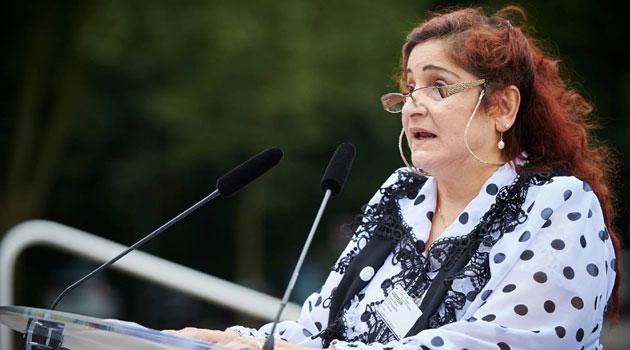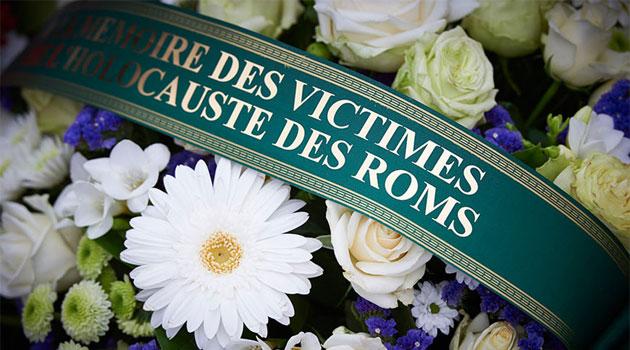The Council of Europe honoured the memory of Roma Holocaust victims and
survivors with commemorations at the infamous Auschwitz-Birkenau concentration
camp and at the Organisation’s Strasbourg headquarters.
“Remembrance not only focuses on the past, but also points the way to the
future,” said Secretary General Thorbjørn Jagland during a wreath-laying
ceremony at the forecourt of the Palais de l’Europe in Strasbourg.
Joined by Ambassador Katrin Kivi, Permanent Representative of Estonia to the
Council of Europe, Miranda Vuolasranta, President of the European Roma and
Travellers Forum (ERTF) and Nawel Rafik‑Elmrini, Deputy Mayor of Strasbourg, the
Secretary General expressed concern over rising anti‑Semitism and anti-Gypsyism
in several European democracies.
He said that Roma today are “under threat” in several Council of Europe
member States, suffering frequent physical aggression and widespread anti-Roma
hate speech on the Internet, and even in mainstream political discourse. “We had
hoped that the remembrance of the Holocaust of millions of Jews and Roma would
prevent the return of dangerous ideologies. Were we too optimistic?”
On the same day, some 400 Roma and non-Roma young people from across Europe
gathered at Auschwitz-Birkenau for a commemoration called Dikh he na Bister (“Look
and don’t forget”). Six former Roma inmates attended the Auschwitz ceremony,
which was supported by the Council of Europe.
This year marks the 72nd anniversary of the height of the atrocities
committed against Roma during World War II. Roma organisations commemorate this
tragedy on 2 August, the date on which in 1944, some 3 000 Roma were
exterminated in the gas chambers of the so-called "Zigeunerlager" (Gypsy camp)
at Auschwitz-Birkenau.
While it is not known exactly how many were killed in the Roma Holocaust,
which is also known as Pharrajimos, many historians estimate that the Nazis and
their allies murdered at least one quarter of the estimated one million Roma
living in Europe before World War II.
Speech by Thorbjørn Jagland
Excellencies, Ladies and Gentlemen,
We are gathered here today together with representatives of the Estonian
Chairmanship of the Committee of Ministers of the Council of Europe, of the
European Roma and Travellers Forum (ERTF), and of the City of Strasbourg, to pay
homage to the victims of the Roma Holocaust (Pharrajimos) – to the Roma men,
women and children murdered in the extermination camp of Auschwitz on 2 August
1944 – but also to the hundreds of thousands of Roma who perished all over
Europe during the Second World War, through the hands of henchmen of the Nazi
and other regimes and their allies.
We are gathered here today on 2 August at 12 o’clock noon, at the same time
as the main ceremony takes place in Ausschwitz, and many related events all over
Europe.
In the night from the 2nd to the 3rd of August 1944, several thousand Sinti
and Roma were massacred at the so-called Zigeunerlager (the “Gypsy camp”) in the
Auschwitz-Birkenau concentration camp, mainly women, children and the elderly.
The crematorium burnt all night.
The horrors of the Roma Holocaust are an undeniable part of our history.
However, for a long time, Europe has turned a blind eye on to what had happened.
We are here to keep the memory alive.
It is crucial to end the silence that has lasted for decades. Europe has a
duty to face up to its legacy and to learn from past mistakes so that there will
be no repetition.
But remembrance does not only focus on the past, it also builds bridges
between the past and the present, and it points the way for the future.
We had hoped that the remembrance of the Holocaust of millions of Jews and
Roma would prevent the return of dangerous ideologies. Were we too optimistic?
Anti-Semitism and anti-Gypsyism are on the increase again in several European
democracies.
Extremist’s movements and extreme right-wing parties are mushrooming in many
Council of Europe member States.
Roma are not welcome in their home countries, let alone in countries
receiving them.
Many in Europe not only forgot past sufferings, but continued the century-old
practices of discrimination, ghettoization and segregation of Roma.
Today, Roma are under threat in several Council of Europe member States.
Physical aggression against them is frequent.
Anti-Roma hate speech is widespread on the Internet, and can even be found in
the mainstream political discourse.
What can we do to change the way how Roma are seen and treated?
The Council of Europe, the European Human Rights watchdog and defender, has
taken up this challenge and has made the fight for the social inclusion of Roma
a political priority.
We have worked with well-known and respected scholars to elaborate materials
for the teaching of the Roma Holocaust. Innovative projects and tools are
promoted to foster knowledge of the common history of Roma and non-Roma. The
objective is to encourage the recognition of the Roma Holocaust, and to
acknowledge the positive contribution by Roma to Europe’s historical and
cultural heritage and diversity.
We are running the Dosta! campaign throughout many member States, to address
the negative stereotypes about Roma.
We are running projects to assist municipalities and regions to strengthen
Roma inclusion, and to improve the mediation between Roma communities and public
authorities.
We are working with the OSCE and the European Union, with ministries,
schools, and civil society organisations.
However, as European citizens, every one of us, we have the responsibility
not to close our eyes. We must know, inform, educate, and empower. And stand up
for non-discrimination and the protection of human rights and democracy.
This ceremony helps to keep the memory of the Roma Holocaust alive. And the
key message is: “Never again!”
May the remembrance also help to create a better future for all Sinti and
Roma in Europe.
Thank you.

